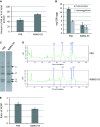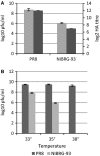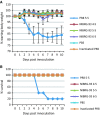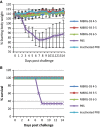A promoter mutation in the haemagglutinin segment of influenza A virus generates an effective candidate live attenuated vaccine
- PMID: 25087607
- PMCID: PMC4262274
- DOI: 10.1111/irv.12274
A promoter mutation in the haemagglutinin segment of influenza A virus generates an effective candidate live attenuated vaccine
Abstract
Background: Annual seasonal and pandemic influenza vaccines need to be produced in a very tight time frame. Haemagglutinin (HA) is the major immunogenic component of influenza vaccines, and there is a lot of interest in improving candidate vaccine viruses.
Objectives: It has been shown elsewhere that mutations introduced in the non-coding region of influenza genome segments can upregulate protein expression. Our objective was to assess a virus based on the laboratory strain A/PR/8/34 (PR8) containing a modified 3' non-coding region of RNA segment 4 (haemagglutinin).
Methods: NIBRG-93 was generated using reverse genetics. HA protein expression and growth properties were assessed. The virus phenotype suggested that it could be a candidate for use as a live attenuated vaccine, so in vivo studies were performed to assess its suitability.
Results: NIBRG-93 virus has enhanced haemagglutinin production and is significantly attenuated. Electron microscopy (EM) shows that the modified virus produces a large proportion of 'virus-like particles' that consist of budded cell membrane covered in HA but lacking M1 protein. The virus was shown to be attenuated in mice and offered complete protection against lethal challenge.
Conclusions: We demonstrate that NIBRG-93 is an effective live attenuated vaccine virus protecting mice against lethal challenge and reducing virus shedding.
Keywords: Candidate vaccine virus; haemagglutinin; influenza; live attenuated; promoter mutation; vaccine.
© 2014 The Authors. Influenza and Other Respiratory Viruses Published by John Wiley & Sons Ltd.
Figures







References
-
- Gerdil C. The annual production cycle for influenza vaccine. Vaccine. 2003;21:1776–1779. - PubMed
-
- Nicolson C, Major D, Wood JM, et al. Generation of influenza vaccine viruses on Vero cells by reverse genetics: an H5N1 candidate vaccine strain produced under a quality system. Vaccine. 2005;23:2943–2952. - PubMed
-
- Harvey R, Nicolson C, Johnson RE, et al. Improved haemagglutinin antigen content in H5N1 candidate vaccine viruses with chimeric haemagglutinin molecules. Vaccine. 2010;28:8008–8014. - PubMed
MeSH terms
Substances
Grants and funding
LinkOut - more resources
Full Text Sources
Other Literature Sources
Medical
Research Materials

